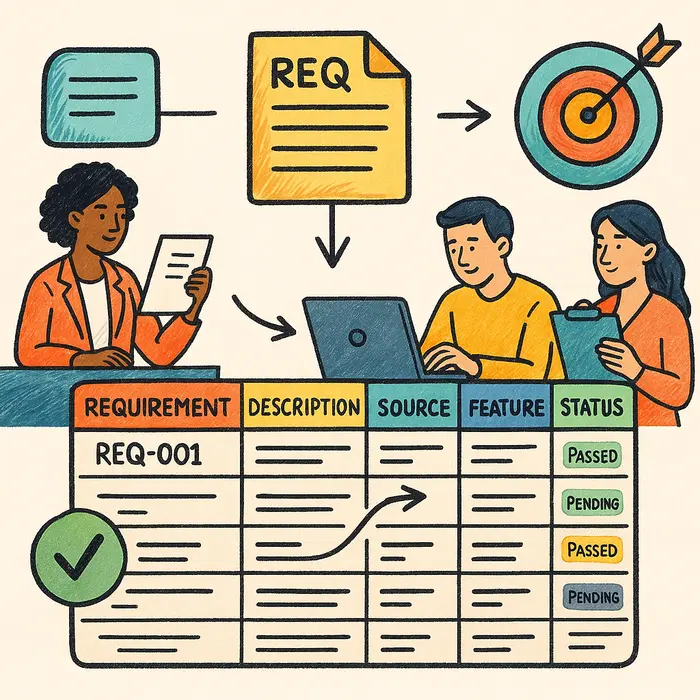Projects fail for all kinds of reasons—but one of the quietest killers is lost requirements. You gather the needs, document them carefully… and somehow, a few never make it into the final product.
Enter the Requirements Traceability Matrix (RTM)—a simple yet powerful tool that helps you track each requirement from start to finish, ensuring nothing slips through the cracks.
** What Is a Requirements Traceability Matrix?**
A Requirements Traceability Matrix (RTM) is a document or table that links each requirement to its source and maps it forward through the lifecycle—design, development, testing, and delivery.
It answers:
Where did this requirement come from?
Has it been addressed in the solution?
Has it been tested and validated?
** Why an RTM Matters**
Whether you’re working on a small internal project or a large enterprise rollout, an RTM helps you:
Ensure full requirement coverage
Align work with business goals
Detect gaps or missed features early
Support regulatory or audit requirements
Manage scope creep with clear traceability
Simplify change impact analysis
In short—it keeps your project honest.
** What Goes in an RTM?**
Here’s a common column structure for a basic RTM:
| Requirement ID | Requirement Description | Source | Functional Spec Ref | Design Ref | Test Case ID | Status |
|---|
You can customize it with other fields like:
Priority
Owner
Risk level
Notes or rationale
Sprint or release #
** How to Create an RTM (Step-by-Step)**
Step 1: Gather Your Requirements
Pull all validated requirements into a centralized list. These might come from:
Business Requirements Document (BRD)
User stories
Stakeholder interviews
Regulatory documents
Give each one a unique ID for easy reference (e.g., REQ-001).
Step 2: Identify Sources and Dependencies
For each requirement, note:
The origin (stakeholder, document, law)
Related business goals
Any dependencies on other features or systems
This ensures you can justify and explain each item later.
Step 3: Map Forward
Link each requirement to:
Design elements or architecture decisions
Development tasks or features
Test cases (manual or automated)
Releases or sprints
This mapping shows how each requirement moves through the lifecycle.
Step 4: Track Status
Add a status column (e.g., “Planned,” “In Development,” “Tested,” “Delivered”). This makes it easy to check progress at a glance.
Step 5: Maintain It Regularly
Update the RTM as requirements evolve:
Add new links when test cases are written
Flag gaps if test cases are missing
Note changes if scope shifts
Make this part of your regular requirements review or sprint planning.
** RTM in Agile Projects**
In Agile, traceability still matters—even if documentation is lighter. You can use:
Jira or Azure DevOps custom fields and linking
Traceability plugins or add-ons
Excel or Google Sheets for lightweight tracking
Link epics → user stories → test cases. Keep it lean, but consistent.
** Example RTM (Simple Format)**
| Req ID | Description | Source | Feature | Test Case | Status |
|---|---|---|---|---|---|
| REQ-001 | Users must reset password via email | Stakeholder A | User Profile > Reset Password | TC-004 | Passed |
| REQ-002 | Show product suggestions on checkout | BRD v2 | Checkout Page | TC-017 | In Dev |
** Tips for a Useful RTM**
Keep IDs consistent: Unique IDs prevent confusion and help with filtering/searching.
Use filters and color coding: Make large matrices more navigable.
Automate where possible: Use tools that can link requirements to test cases or code.
Focus on value, not volume: Track what’s important to deliver—not every minor detail.
Review regularly: Make the RTM part of sprint reviews or test planning.
** Common Pitfalls to Avoid**
Creating the RTM too late (after dev starts)
Treating it as a “one-and-done” document
Tracking too much—keep it actionable
Skipping traceability for “obvious” requirements
Final Takeaway
A Requirements Traceability Matrix may sound like a formal artifact—but at its core, it’s a simple, visual way to protect your project’s success.
When you create one early, maintain it well, and use it actively, the RTM becomes a strategic tool—not just a checkbox.
“If you can’t trace it, you can’t test it. And if you can’t test it, you can’t trust it.”
Start your RTM today. Even a simple spreadsheet can bring big clarity.
